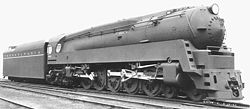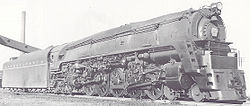
PRR Q1
Encyclopedia

Pennsylvania Railroad
The Pennsylvania Railroad was an American Class I railroad, founded in 1846. Commonly referred to as the "Pennsy", the PRR was headquartered in Philadelphia, Pennsylvania....
's class Q1 comprised a single experimental steam locomotive
Steam locomotive
A steam locomotive is a railway locomotive that produces its power through a steam engine. These locomotives are fueled by burning some combustible material, usually coal, wood or oil, to produce steam in a boiler, which drives the steam engine...
for freight service, #6130, built in March 1942
1942 in rail transport
-January events:* January 1 – Government of India takes over Bombay, Baroda and Central India Railway and Assam Bengal Railway, merging the latter with the Eastern Bengal Railway to form the Bengal Assam Railway.-April events:...
. A duplex locomotive
Duplex locomotive
A duplex locomotive is a steam locomotive that divides the driving force on its wheels by using two pairs of cylinders rigidly mounted to a single locomotive frame; it is not an articulated locomotive...
, it had a wheel arrangement
Wheel arrangement
In rail transport, a wheel arrangement is a system of classifying the way in which wheels are distributed beneath a locomotive.. Several notations exist to describe the wheel assemblies of a locomotive by type, position, and connections, with the adopted notations varying by country...
of 4-6-4-4
4-6-4-4
In Whyte notation, a 4-6-4-4 is a railroad steam locomotive that has four leading wheels followed by six coupled driving wheels, a second set of four driving wheels and four trailing wheels.Other equivalent classifications are:...
, comprising a four-wheel leading truck, two sets of driving wheel
Driving wheel
On a steam locomotive, a driving wheel is a powered wheel which is driven by the locomotive's pistons...
s (six followed by four) in a rigid locomotive frame
Locomotive frame
A locomotive frame is the structure that forms the backbone of the railway locomotive, giving it strength and supporting the superstructure elements such as a cab, boiler or bodywork. The vast majority of locomotives have had a frame structure of some kind...
, and a four-wheel trailing truck. The first group of six driving wheels was driven by a pair of cylinder
Cylinder (engine)
A cylinder is the central working part of a reciprocating engine or pump, the space in which a piston travels. Multiple cylinders are commonly arranged side by side in a bank, or engine block, which is typically cast from aluminum or cast iron before receiving precision machine work...
s mounted conventionally in front of them, while the rear four driving wheels were driven by cylinders mounted behind them on either side of the firebox.
Unusual for a locomotive designed for pure freight service, it was given passenger-locomotive sized driving wheels at 77 in (1.96 m) and streamlining
Streamliner
A streamliner is a vehicle incorporating streamlining in a shape providing reduced air resistance. The term is applied to high-speed railway trainsets of the 1930s to 1950s, and to their successor "bullet trains". Less commonly, the term is applied to fully faired recumbent bicycles...
in the form of a bluntly pointed nosecone on the smokebox
Smokebox
A smokebox is one of the major basic parts of a Steam locomotive exhaust system. Smoke and hot gases pass from the firebox through tubes where they pass heat to the surrounding water in the boiler. The smoke then enters the smokebox, and is exhausted to the atmosphere through the chimney .To assist...
front as well as long side skirts covering up the locomotive's pipework. The cab front was set at a rakish angle. The tender, although given a freight locomotive's "doghouse" on the rear deck for the head-end brakeman, was otherwise a streamlined affair very similar to that used on the S1
PRR S1
The PRR S1 class steam locomotive was an experimental locomotive that was the largest rigid frame passenger locomotive ever built. The streamlined Art Deco styled shell of the locomotive was designed by Raymond Loewy....
, S2
PRR S2
The Pennsylvania Railroad's class S2 was a steam turbine locomotive. Only one prototype was built, #6200, delivered in 1944. The S2 was the sole example of the 6-8-6 wheel arrangement in the Whyte notation, featuring a six-wheel leading truck, eight driving wheels, and a six-wheel trailing truck...
, and T1
PRR T1
The Pennsylvania Railroad's 52 T1 class duplex-drive 4-4-4-4 steam locomotives, introduced in 1942 and 1946 , were their last-built steam locomotives and their most controversial. They were ambitious, technologically sophisticated, powerful, fast, and uniquely streamlined by Raymond Loewy...
passenger locomotives.
During its short service life it spent more time in shops or the enginehouse than being run, accumulating only about 65,000 service miles in its career. It was assigned to the St. Clair Avenue Enginehouse in Columbus, Ohio
Columbus, Ohio
Columbus is the capital of and the largest city in the U.S. state of Ohio. The broader metropolitan area encompasses several counties and is the third largest in Ohio behind those of Cleveland and Cincinnati. Columbus is the third largest city in the American Midwest, and the fifteenth largest city...
and ran mostly in the Ohio area and to Chicago, Illinois.
In December 1944 it appeared at a PRR exhibition in Chicago's Union Station
Union Station (Chicago)
Union Station is a major train station that opened in 1925 in Chicago, replacing an earlier 1881 station. It is now the only intercity rail terminal in Chicago, as well as being the city's primary terminal for commuter trains. The station stands on the west side of the Chicago River between Adams...
entitled "Presenting a Line of Modern Coal-Burning Steam Locomotives". At some time during the next year it lost much of its streamlining, the nosecone being removed in favor of a conventional PRR smokebox front including the keystone numberplate placed centrally on the small smokebox door. A headlamp bracket mounted above that door also hung the locomotive's bell. The side skirting was cut back to expose pipework and fittings for easier maintenance. The skyline casing atop the boiler remained in place.

The PRR considered the Q1 design unfit for series production, and railroad historians consider it largely a failure. The backwards-driving rear cylinders were a poor choice; mounted next to the firebox, each constrained the other's size, and the area by the firebox was dusty and hot, which increased cylinder wear. These problems had previously been encountered on the B&O
Baltimore and Ohio Railroad
The Baltimore and Ohio Railroad was one of the oldest railroads in the United States and the first common carrier railroad. It came into being mostly because the city of Baltimore wanted to compete with the newly constructed Erie Canal and another canal being proposed by Pennsylvania, which...
's N-1
Baltimore and Ohio Class N-1
The Baltimore and Ohio Railroad's sole Class N-1 steam locomotive, #5600 George H. Emerson, was the first duplex locomotive and the first 4-4-4-4 locomotive ever built. It was designed and built by the railroad's own shops in 1937. The rear set of cylinders were placed beside the firebox. This...
duplex. The length of steam pipes required also meant a fair degree of power loss. Added to this, the passenger-locomotive sized drivers were a poor choice for a freight locomotive.
From its experiences with this locomotive, the PRR came up with an improved design, the Q2
PRR Q2
The Pennsylvania Railroad's class Q2 comprised one prototype and twenty-five production duplex steam locomotives of 4-4-6-4 wheel arrangement....
. This had normal-sized drivers, cylinders mounted in front of the wheels they drove, and were built largely unstreamlined.

